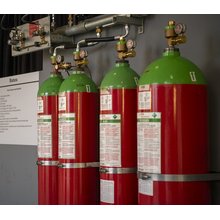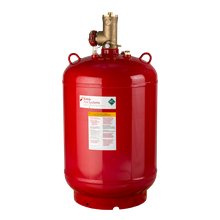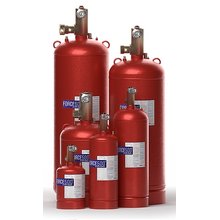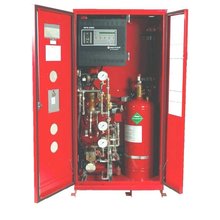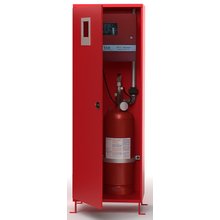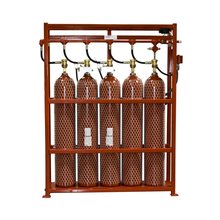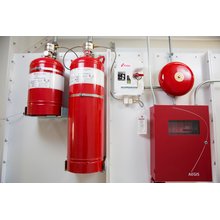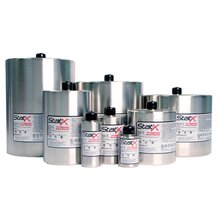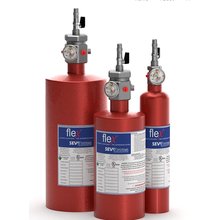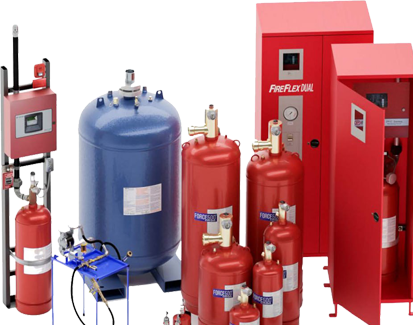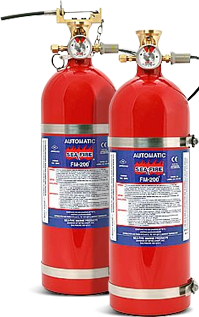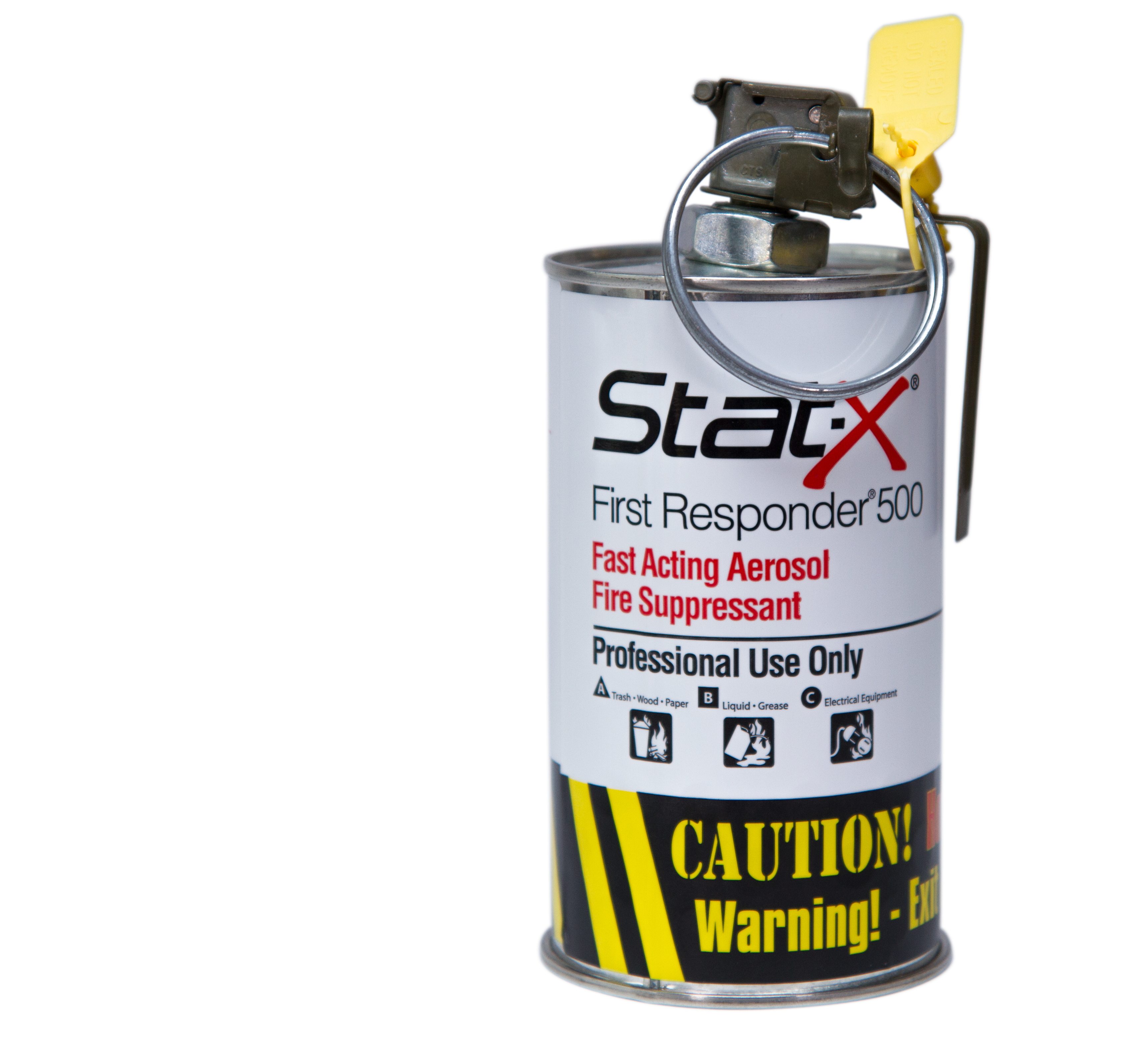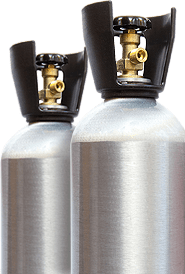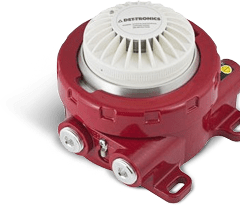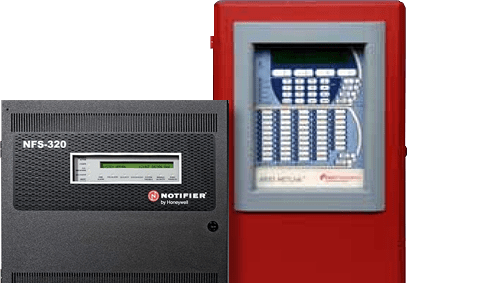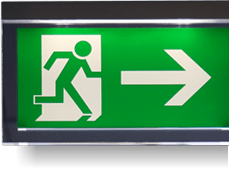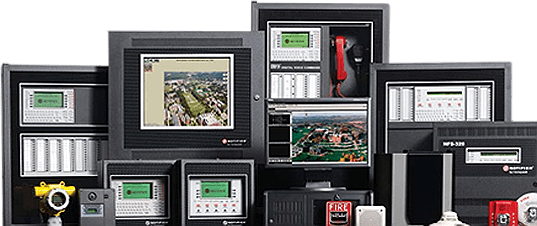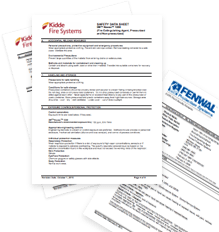Fire Suppression Systems
There are several types of fire suppression systems, ranging from the classic water-based sprinkler system to systems that use gasses and leave no residue after being discharged. Each type of fire suppression system is designed to extinguish different types of fires that may be found within a building or workplace.
Fire suppression systems consist of a network of pipes that cover the majority or entirety of the building they are designed to protect. When the fire suppression system is activated, the pipes fill with the chosen fire suppressant to extinguish the fire.
Fire suppression systems can also depend on what it is that they are trying to protect - some may be a local application and protect a very small area, and others may be a flooding systems where the entire area is covered by a single type of fire suppression system. Local application systems may be used to protect a piece of expensive equipment within a large room, while flooding systems may be used to protect an entire room using the same suppressant.
Types of Fire Suppression Systems
Wet Chemical Fire Suppression System (NFPA 17A)
Disperses a liquid that rapidly cools when evaporated, preventing the fire from further combustion. The liquid, when mixed with oils and fats, creates a foam which also prevents reignition.
Dry Chemical Fire Suppression System (NFPA 17)
Uses a dry chemical powder which acts to smother the fire. The powder is stored in a pressurized tank; when the system is activated, the tank opens and releases the powder.
Foam Systems
Foam Water Fire Suppression System (NFPA 16)
Works by utilizing water and foam concentrate. The concentrate mixes with the water within the piping and is then dispersed through a sprinkler system. These systems may also allow for water to be dispensed first, followed by the foam water mixture.
High Volume Expansion Foam Fire Suppression System (NFPA 11)
A total flooding system that releases a large amount of foam from discharge heads. The foam then acts to suffocate the fire and insulate the protected area.
Carbon Dioxide Fire Suppression System (NFPA 12)
Removes the oxygen fire needs to combust. CO2 fire suppression systems leave behind no residue and are non-conductive; however, they are lethal to humans and cannot be used in habitable areas.
Halon System Fire Suppression System (NFPA 12A)
Extinguishes fires by chemically interrupting the combustion chain reaction process. Halon systems have been banned since January 1, 1994 because of their Ozone Depletion Potential.
Clean Agent Fire Suppression System (NFPA 2001)
Has two methods to success, removing either the oxygen or the heat from a fire. They are called clean agent systems because there is no residue left behind after the system has been activated. These systems are non-conductive and can be non-toxic, meaning they can be used in habitable areas.
Automatic Water Mist Fire Suppression System (NFPA 750)
Utilizes water the same way as traditional sprinkler systems, with the key difference of spraying a mist instead. Mist is a more effective suppressant than water due to the larger surface area of water exposed to the fire than that in a traditional sprinkler system.
Condensed Aerosol Fire-Extinguishing System (NFPA 2010)
Utilizes both dry chemicals and gasses to extinguish fire. These systems should not be used in habitable areas or in areas with sensitive electronics due to corrosion risk.
What is the best type of fire suppression system for your application?
any possible solutions when it comes to choosing which type of fire suppression system will work best for your application, and many aspects to consider when selecting your fire suppression system. Some important things to consider when selecting a fire suppression system are: the down time and clean up after activation, the impact on the environment, the cost of the system, the presence of people in the area, and the sensitivity of the area being protected.
Clean chemical agents such as FM-200, Novec 1230, or inert gasses are the best choice if minimal downtime after activation is important to you. These chemicals can be used in a wide array of applications as they are non-conductive, as well as due to their ability to cleanly suppress fires.
Environmental impact is a key consideration in the modern world, and unfortunately, not all fire suppression systems are environmentally friendly (Halon gasses are banned because of their threats to the environment). Water and inert gasses are therefore great first choices, as they are not only naturally occurring but also abundant and readily available.
What fire suppression services does Control Fire Systems offer?
Control Fire Systems offers not only fire suppression systems in Toronto, but assessments, services, repairs, and testing for your fire suppression system as well. Our staff is fully qualified and licensed to install, repair, service, and test fire suppression equipment.
Our inspection and maintenance technicians are trained based on the guidelines of our partnering manufacturers. Control Fire Systems is committed to keeping all staff up to date in their training in order to accommodate for the changes that occur within the industry.
The first step in our installation process is to evaluate your new building or facility for fire protection. Our engineers will then configure the fire suppression system so that it fits your needs, and effectively suppresses any fire that may occur.
After an initial assessment has been made by our engineers, our experienced and certified team of installation experts will carry out all of the remaining installation services. These services can include the installation of suppression system piping, the fitting of the dispersal system, and the storage and pressurization of the suppressant.
Why choose Control Fire Systems?
As Canada's largest selection of fire suppression systems, Control Fire Systems is your go-to choice for all your fire suppression system needs and questions. We have over 45 years of experience working with fire suppression systems in the Toronto area.
Our experienced technicians possess the tools and knowledge necessary to outfit your new building with an appropriate fire suppression system. There is no job too big or small: our expertly designed suppression systems are tailored to fit the needs of you and your building.
We also understand that the cost of a fire suppression system can be intimidating - that's why we take careful consideration of your budget when designing your fire suppression system. Control Fire Systems offers a 12-month warranty period, as well as 24 hours on-call emergency service.
FAQ
What is the meaning of fire suppression?
Fire Suppression is the act of reducing the amount of heat released by extinguishing, controlling, or preventing a fire by means of direct and sufficient application of chemicals, water, or other applications where seen fit.
What are the four methods of fire suppression?
The four methods of fire suppression are cooling, smothering, starvation, and interruption of the chemical process. Cooling a fire is perhaps the most common method of fire suppression, cooling the fuel to a point where it no longer releases flammable vapors. Smothering a fire involves removing oxygen from the burning material, causing the fire to cease. Starvation of a fire is the removal of the fuel source, eliminating the burnable material. Interrupting the chemical process involves the use of chemicals that stop the chain reaction of combustion.
What are the most commonly used fire suppression systems?
There are three types of fire suppression systems that are most commonly used throughout the industry. Water is the most common type of fire suppression system, as it is readily available, environmentally friendly, and cost effective. Chemical agents are another type of commonly used fire suppression systems, relying on the ability of the chemical to extinguish the fire. Lastly, gasses are commonly found in fire suppression systems as they are clean agents and non-conductive, preventing the damage of valuable or sensitive items.
What is the difference between fire protection and fire suppression?
A fire protection system is designed to protect a building's occupants and valuables while minimizing the damage associated with the fire. Fire protection systems, meanwhile, may be active, like a sprinkler system, or passive, such as structural improvements.
A fire suppression system is the active system employed when a fire occurs. The objective of a fire suppression system is to extinguish a fire as quickly as possible using chemical substances.
What does a fire suppression system include?
Fire suppression systems are composed of either CO2, dry chemicals, wet chemicals, or clean fire suppression agents. Not all of these systems are suitable for every situation; they are therefore used independently or, sometimes, in conjunction with other suppressants.
How much do fire suppression systems cost?
The cost of a fire suppression system is dependent on the size of the structure or facility being outfitted, as well as the type of fire suppression system to be installed. There is no single cost of a fire suppression system, as this figure is heavily dependent on your unique circumstances.
Whatever your needs or budget may be, Control Fire Systems is ready to help. Our professional and experienced staff will guide you in making the best choice when it comes to purchasing your suppression system. Contact us by phone at 1-866-525-8514.




